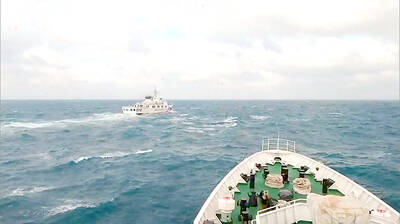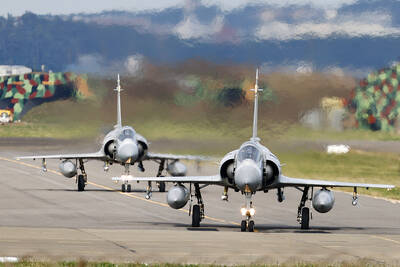The military and national security apparatus was in “full control” when two Chinese Sukhoi-27 fighters crossed the centerline in the Taiwan Strait on June 29, the Ministry of National Defense (MND) said yesterday.
The Chinese-language newspaper United Daily News reported that one of the two Chinese fighter aircraft had crossed the theoretical median maritime border between Taiwan and China while allegedly pursuing a U-2S high-altitude US reconnaissance aircraft.
Two Taiwanese F-16 aircraft intercepted the Su-27s, which subsequently returned to Chinese airspace, the report said.
According to the report, the U-2 was based out of a US base in Osan, South Korea, but took off from Kadena Air Base in Okinawa, Japan, to execute a surveillance mission.
Inquiries to a spokesperson at the US Department of Defense to confirm the presence of a U-2 aircraft near the Taiwan Strait on June 29 remained unanswered by press time yesterday.
The ministry confirmed the veracity of the report, but added that the incident was an isolated case and was not regarded as a provocative act.
The military is closely monitoring the activities of Chinese aircraft in the airspace over the Taiwan Strait, it said in a statement.
“When any emergency situation is detected, the military will immediately send the [Taiwanese] air force to the area to deliver warnings,” the statement said.
Legislators yesterday differed on the significance of the incident.
The intrusion was an act of “aggression, demonstration, provocation and unfriendliness,” Democratic Progressive Party (DPP) caucus whip Tsai Huang-liang (蔡煌瑯) said at a press conference, adding that President Ma Ying-jeou (馬英九) and the ministry should file a protest with Beijing.
The act was “an infringement of our sovereignty,” DPP legislators Wong Chin-chu (翁金珠) and Chen Ting-fei (陳亭妃) said, urging Ma and Premier Wu Den-yih (吳敦義) to protest.
The ministry handled the incident in accordance with standard operation procedure, Presidential Office spokesperson Fang Chiang Tai-chi (范姜泰基) said.
“With current cross-strait relations the best they have been in decades, I don’t think China sent those fighter aircraft to provoke Taiwan. It did so to warn the US against gathering intelligence along its southeastern coast,” Chinese Nationalist Party (KMT) Legislator Lin Yu-fang (林郁方) said.
It might be acceptable for Taipei to express its displeasure to China about the incident, but lodging a protest would be unnecessary, Lin added.
“The incident was just a case that has sometimes occurred during the past decades and no armed aerial confrontation ensued,” Lin said.
Lin said he did not support the idea of Taiwan negotiating the creation of a confidence building mechanism (CBM) with China as a result of the incident.
“The time is not right for CBM talks … and that would worry the US,” he said.
“It’s not unusual for soldiers on the front line to commit such mistakes,” said KMT Legislator Shuai Hua-min (帥化民), a retired army general.
Shuai said Taipei should refrain from overreacting because “the centerline has always been an invisible line and the Chinese aircraft did not make their way deep into Taiwanese territory.”
“It comes down to the pilot’s behavior. Taiwanese aircraft were scrambled and the Chinese side turned back. That’s about it militarily,” he said.
If Taiwan overplays the significance of the incident, it would only stir up more trouble, Shuai said, adding that a similar situation occurred every day after former president Lee Teng-hui (李登輝) defined the cross-strait relationship as “state-to-state” in nature.
“It’s not necessary to demand an explanation from the mainland [China],” Shuai said.
KMT caucus whip Chao Li-yun (趙麗雲) said the caucus would invite ministry officials to brief lawmakers on the incident to clarify possible misunderstandings after the legislature convenes in late September.
ADDITIONAL REPORTING BY STAFF WRITER

The Ministry of Foreign Affairs (MOFA) yesterday said it is closely monitoring developments in Venezuela, and would continue to cooperate with democratic allies and work together for regional and global security, stability, and prosperity. The remarks came after the US on Saturday launched a series of airstrikes in Venezuela and kidnapped Venezuelan President Nicolas Maduro, who was later flown to New York along with his wife. The pair face US charges related to drug trafficking and alleged cooperation with gangs designated as terrorist organizations. Maduro has denied the allegations. The ministry said that it is closely monitoring the political and economic situation

UNRELENTING: China attempted cyberattacks on Taiwan’s critical infrastructure 2.63 million times per day last year, up from 1.23 million in 2023, the NSB said China’s cyberarmy has long engaged in cyberattacks against Taiwan’s critical infrastructure, employing diverse and evolving tactics, the National Security Bureau (NSB) said yesterday, adding that cyberattacks on critical energy infrastructure last year increased 10-fold compared with the previous year. The NSB yesterday released a report titled Analysis on China’s Cyber Threats to Taiwan’s Critical Infrastructure in 2025, outlining the number of cyberattacks, major tactics and hacker groups. Taiwan’s national intelligence community identified a large number of cybersecurity incidents last year, the bureau said in a statement. China’s cyberarmy last year launched an average of 2.63 million intrusion attempts per day targeting Taiwan’s critical

‘SLICING METHOD’: In the event of a blockade, the China Coast Guard would intercept Taiwanese ships while its navy would seek to deter foreign intervention China’s military drills around Taiwan this week signaled potential strategies to cut the nation off from energy supplies and foreign military assistance, a US think tank report said. The Chinese People’s Liberation Army (PLA) conducted what it called “Justice Mission 2025” exercises from Monday to Tuesday in five maritime zones and airspace around Taiwan, calling them a warning to “Taiwanese independence” forces. In a report released on Wednesday, the Institute for the Study of War said the exercises effectively simulated blocking shipping routes to major port cities, including Kaohsiung, Keelung and Hualien. Taiwan would be highly vulnerable under such a blockade, because it

UNDER WAY: The contract for advanced sensor systems would be fulfilled in Florida, and is expected to be completed by June 2031, the Pentagon said Lockheed Martin has been given a contract involving foreign military sales to Taiwan to meet what Washington calls “an urgent operational need” of Taiwan’s air force, the Pentagon said on Wednesday. The contract has a ceiling value of US$328.5 million, with US$157.3 million in foreign military sales funds obligated at the time of award, the Pentagon said in a statement. “This contract provides for the procurement and delivery of 55 Infrared Search and Track Legion Enhanced Sensor Pods, processors, pod containers and processor containers required to meet the urgent operational need of the Taiwan air force,” it said. The contract’s work would be